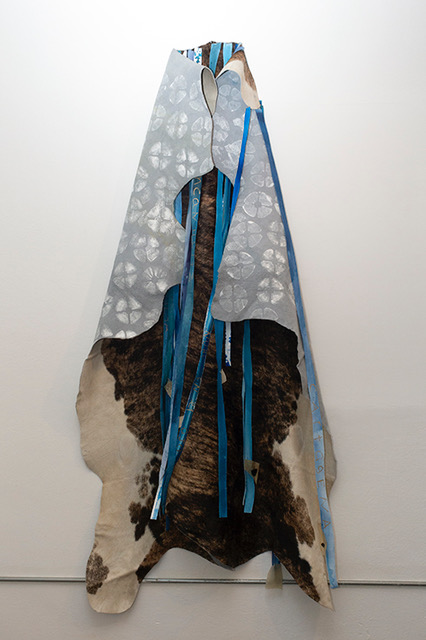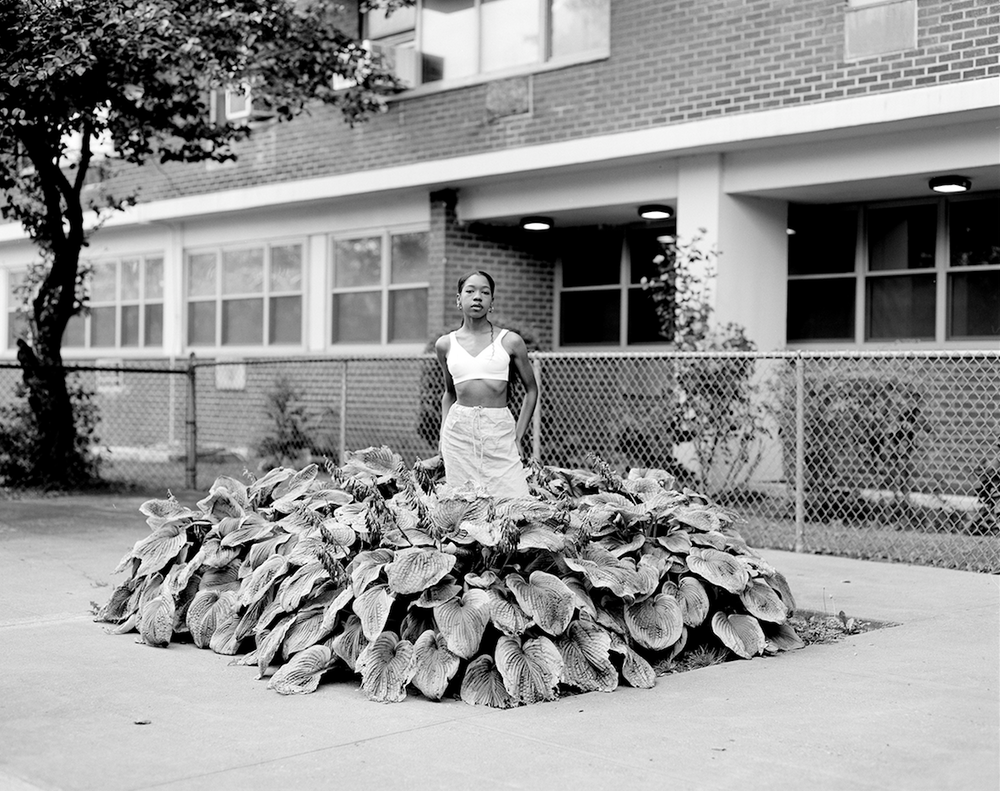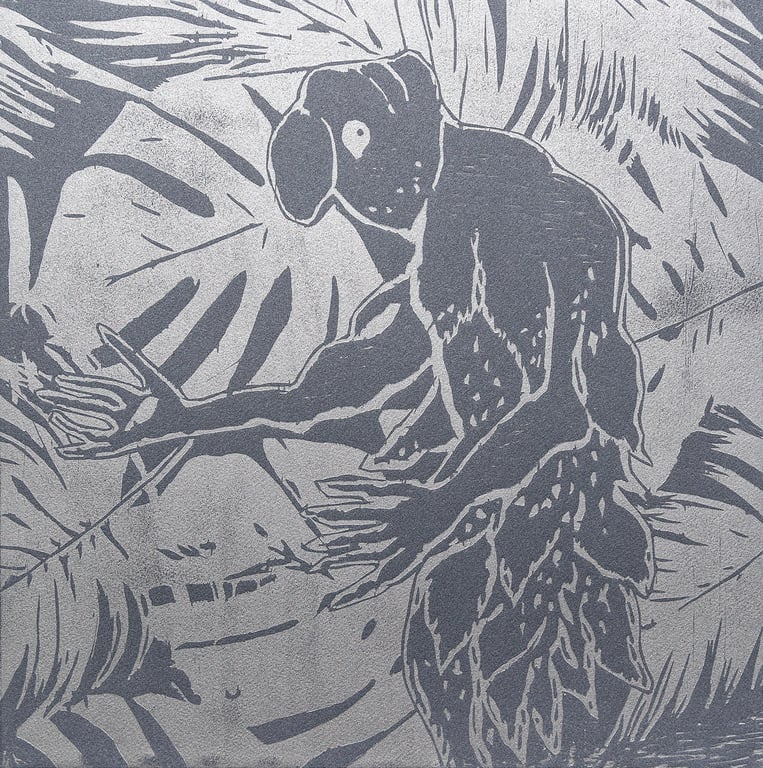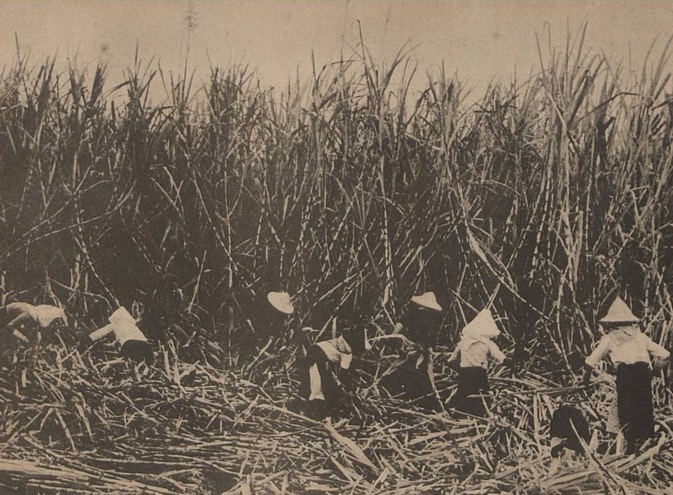
© » KADIST
Yétúndé Olagbaju
Yétúndé Olagbaju’s On becoming a star series recuperates the figure of ‘Mammy’, a stereotype rooted in American slavery that typically depicts a larger, dark skinned woman as a maternal presence, often within a domestic setting, and typically taking care of white children. After being referred to as a Mammy during their undergraduate degree, Olagbaju began exploring the figure in 2016 as a means of healing. Olagbaju’s first presentation on this topic was a book called Black Collectibles: Mammy and Friends (1997) that sells tchotchkes—like salt and pepper shakers or figurines—of the racist mammy image taking different forms, from which Olagbaju exorcised the Mammy images by carefully cutting them out of the book with a razor blade.

© » KADIST
Adriana Bustos
El mar y sus múltiples afluentes (The Sea and its Multiple Tributaries) builds on the concept of trafficking that Adriana Bustos has been exploring over the last decade. The piece represents an apocryphal river and illustrates the routes of the slave trade between the coasts of Africa, Europe, and South America, departing from the Congo River (once called Zaira), and arriving at Río de la Plata, the main river in Buenos Aires that divides Argentina from Uruguay. The work collapses time and space, placing the coasts of colonial empires across the colonies where slaves were taken.

© » KADIST
Minia Biabiany
Musa is a visual and textual work by Minia Biabiany and the starting point of a broader research around the sexuality of Caribbean women, the historical legacy of slavery, and the artist’s own female lineage. Sometimes shown within an installation, sometimes on its own, the video combines images of flowers, landscapes, and bodies, with text in Creole and English. The video is conceived as a weaving, its technique creating stitchings and surfaces, upon which the artist inscribes stories.

© » KADIST
Jared Owens
Hog feed 102 is an exemplary work by Jared Owens that combines two of the artist’s primary signatures: the use of soil smuggled out of the grounds at F. C. I. Fairton, a prison in which Owens was incarcerated, and the stowage diagram of the Brookes slave ship. This diagram from 1788 is a logistical blueprint of how to pack Black bodies efficiently, in tiered serial form, into the hold of a ship. Merging these vocabularies, Owens has laced a burlap sack for pig feed into the work to advance a multi-layered commentary on American prisons as ostensible ‘human farms’ that dehumanize inmates by turning them into a commodity for the prison industrial complex.

© » KADIST
Dread Scott
In conjunction with his first NFT sale of White Male Dread Scott made and circulated a poster titled Whites For Sale . The indigo-colored poster advertises a “cargo” of newly arrived white slaves, from which one will be for sale. This work is adapted from a 1796 slave sale announcement poster that is now archived in the library at Columbia University, NYC.

© » KADIST
Caroline Déodat
Landslides is a cinematographic essay/poem by Caroline Déodat in which fictional images are the result of research into the memories of a Mauritian dance born during colonial slavery, the Sega. In the film, the contemporary Mauritian dancer Jean-Renat Anamah crosses mythical landscapes of the Sega that merge with intimate territories. From the pixels of the digital image and the signals of electronic music, this film exhumes in layers of landscapes the spectres of a ritual erased by history through a personal genealogy: between haunting memory and deferred archive.

© » KADIST
Joscelyn Gardner
Drawing & Print (Drawing & Print)
Creole Portraits III alludes to the 18th century practice by slave women on Caribbean plantations of using tropical plants as natural abortifacients. As an act of political resistance against their exploitation as “breeders” of new slaves and to protest the inhumanity of slavery, some slave women chose to either abort or kill their offspring. Armed with practical knowledge passed on orally from their African ancestors and/or Amerindian counterparts, enslaved Creole women collected the seeds, bark, flowers, sap, and roots from various plants which allowed them to secretly put an end to their pregnancies.

© » KADIST
Noé Martínez
As he investigates the forms that slavery took through different events that occurred during the sixteenth century in the Huasteca region of Mexico, Noé Martínez tells, in a non-linear narrative, the history of human trafficking in Relación de tráfico de personas 1525-1533 I (Study of Trafficking of Persons 1525–1533 I) . Both the departure of Huasteco Indians from the Americas, and the arrival of Africans from Cape Verde, Angola, Congo and Mozambique unravel in Martinez work as a story that has remained sealed in the colonial archives, and that continues under different guises in contemporary times. Relación de tráfico de personas 1525-1533 I is part of a series made of interventions in tanned leathers that refer to the exchange of human beings for pack animals and cattle in the Caribbean Sea.

© » KADIST
Chanell Stone
Natura Negra , which translates to “Black Nature”, is a black-and-white photographic series by Chanell Stone that explores the connection between the Black body and nature within man-made environments. The series features a compilation of environmental portraits staged in urban “forests” that explore the notion of “holding space” within one’s immediate environment. Each image depicts an effort to reclaim and reconnect with the earth, even in spaces of compartmentalized nature like backyard gardens, flora intended as urban beautification, and lush public spaces.

© » KADIST
Troy Chew
Too Many Names by Troy Chew is a patchwork of contemporary Black culture and resistance, including hand-sewn symbols and patterns found in the coats of arms of the kings of the Dahomey region (now Benin) that ruled from 1600-1900. This painting is part of the series Out the Mud, a longterm project in which the artist explores African American history through the lens of traditional mudcloth techniques found in the West African countries involved in the Transatlantic-slave trade. The title of the series references the technique and materials for making mudcloth.

© » KADIST
Ana Vaz
Há Terra! (There Is Land!) is a short film by Ana Vaz that picks up on the artist’s previous film A Idade da Pedra (2013), in which Vaz imagined premodernity in her native Brazil.

© » KADIST
Leah Gordon
The Caste Portraits Series by Leah Gordon investigates the practice of grading skin color from black to white, which marked the extent of racial mixing in 18th century Haiti. Médéric Moreau de St Mery (1750-1819), a French créole slave owner and freemason living in Saint Domingue (now Haiti), created a taxonomy of race classifying skin color from black to white using names derived from mythology, natural history, and bestial miscegenation. His Description topographique, physique, civile, politique et historique de la partie française de l’isle Saint-Domingue (1789) hierarchizes 128 possible combinations of black-white miscegenation into nine categories (the sacatra, the griffe, the marabout, the mulâtre, the quarteron, the métis, the mamelouk, the quarteronné, and the sang-melé).

© » KADIST
Uriel Orlow
The series The Memory of Trees is specifically about trees, and what trees have witnessed in South Africa: for example, trees that were used as locations for slave trading, or trees that was during the anti-Apartheid struggle as a kind of identifier for a safe house for activists who were fleeing from security forces. Trees and plants are connected and embedded in history; but not only as witnesses and onlookers; Orlow tries to think about plants as active agents in history. This perspective allows for an oblique view of history especially when it comes to specific loci of violence such as in South Africa.

© » KADIST
Danielle Dean
In True Red Ruin (Elmina Castle) , Danielle Dean uses archival documents to re-imagine colonial history from the 1400s, while also referencing her own personal history. Elmina Castle was built in Ghana in 1482 as a Portuguese trading post, and later became a key location in the Atlantic slave trade. Dean’s re-enactment is set in an affordable housing community in Houston, Texas, where her half-sister Ashstress Agwunobi lives, and who also performs the role of “the native.” Dean plays the role of “the prospector,” who plans to “colonize” her sister’s home by bringing a wobbly red cardboard castle into the grounds of the community and getting the locals to help build it and work there.

© » KADIST
Sancintya Mohini Simpson
Drawing & Print (Drawing & Print)
And words were whispered by Sancintya Mohini Simpson is a series of ten works on paper based on the lived experiences of Indian women taken to the Natal region of South Africa from the 1860s to the early 1900s to work in tea and sugarcane plantations during apartheid, which included servitude in its broadest and most sinister definition. This often-overlooked chapter in colonial history is close to the artist, as her maternal family was contracted to a sugar plantation in Natal, then one of the four British colonies in South Africa. These indentured servants, derogatorily called ‘coolies’, were employees by title, but were effectually slaves.

© » KADIST
Carla Zaccagnini
De sino à sina (From Bell to Fate) is a six-channel sound installation by Carla Zaccagnini exploring the relationship between modern Brazil and its colonial past. The sound installation is made from a recording of the bell at Capela de Nossa Senhora do Rosário dos Homens Brancos, a Baroque-style chapel that is one of the first chapels in Ouro Preto (previously Vila Rica) in the region of Minas Gerais. The work references the execution of José da Silva Xavier (1746-1792), also known as “Tiradentes”.

© » KADIST
Kara Walker
In her masterpiece 8 Possible Beginnings or The Creation of African-America , Walker unravels just that, the story of struggle, oppression, escape and the complexities of power dynamics in the history following slave trade in America. Her use of contour and silhouette accentuate emotion with rigor, she reduces the narrative to black and white as gruesome acts of sex and violence address trauma, fear and suffering through a majestic play of shadow and light.

© » KADIST
Hank Willis Thomas
Drawing & Print (Drawing & Print)
Shot in black and white and printed on a glittery carborundum surface, Black Hands, White Cotton both confronts and abstracts the subject of its title. As with many of his works, the artist has taken a found image and manipulated it to draw out and dramatize the formal contrast between the black hands holding white cotton. Cotton, of course is one of the most familiar fabric sources to us, and becomes incredibly soft once processed.
Carla Zaccagnini
- year born: 1973
- gender: female
- nationality: Brazilian
- home town: Buenos Aires, Argentina
Troy Chew
Spanning painting, drawing, and sculpture, Troy Chew’s practice reflects on the legacy of the African diaspora through the lens of urban culture...
Danielle Dean
Danielle Dean creates videos that use appropriated language from archives of advertisements, political speeches, newscasts, and pop culture to create dialogues to investigate capitalism, post-colonialism, and patriarchy...
Sancintya Mohini Simpson
Sancintya Mohini Simpson is an artist, writer, and researcher whose work addresses the impact of colonization on the historical and lived experiences of her family and broader diasporic communities...
Hank Willis Thomas
- location: New York, New York
- year born: 1976
- gender: male
- nationality: American
- home town: Plainfield, New Jersey
Chanell Stone
Chanell Stone’s practice explores what she describes as the “re-naturing” of the Black body to the American landscape—an act that aims to complicate and sublimate the history of American slavery into a reimagined relationship between African Americans and the earth...
Adriana Bustos
Adriana Bustos creates a narrative discourse through installation, video, photography and drawing, in which her reflections on prevailing social, political or religious oppression appear in non-linear interpretations of history...
Kara Walker
- location: New York, New York
- year born: 1969
- gender: female
- nationality: American
- home town: Stockton, California
Jared Owens
During more than 18 years of collective incarceration, Jared Owens became a self-taught artist, working in painting, sculpture, and installation, using materials and references culled from penal matter...
Dread Scott
Dread Scott is an interdisciplinary artist who for three decades has made work that encourages viewers to re-examine cohering ideals of American society...
Minia Biabiany
Minia Biabiany’s practice is concerned with the past and ongoing effects of colonialism, exploring the poetics of resistance embedded in everyday life practices, and translating this research into the exhibition space through careful consideration of the cultural and spiritual implications of the material she uses, and the techniques she employs...
Leah Gordon
Leah Gordon is an artist, curator, and writer, whose work considers the intervolved and intersectional histories of the Caribbean plantation system, the Trans-Atlantic Slave Trade, the Enclosure Acts and the creation of the British working-class...
Joscelyn Gardner
Joscelyn Gardner is a Caribbean / Canadian visual artist working primarily with printmaking and multimedia installation...
Uriel Orlow
In his research-based and process-oriented practice Uriel Orlow’s work is concerned with “spatial manifestations of memory, blind spots of representation and forms of haunting”...
Ana Vaz
Ana Vaz is an artist and filmmaker whose works speculate on the relationships between self and other, and myth and history, through a cosmology of signs, references, and perspectives...
-
2000-2009
Kara Walker
2005In her masterpiece 8 Possible Beginnings or The Creation of African-America , Walker unravels just that, the story of struggle, oppression, escape and the complexities of power dynamics in the history following slave trade in America...
Joscelyn Gardner
Drawing & Print
2009(Drawing & Print) Creole Portraits III alludes to the 18th century practice by slave women on Caribbean plantations of using tropical plants as natural abortifacients...
-
2010-2019
Leah Gordon
2012The Caste Portraits Series by Leah Gordon investigates the practice of grading skin color from black to white, which marked the extent of racial mixing in 18th century Haiti...
Hank Willis Thomas
Drawing & Print
2014(Drawing & Print) Shot in black and white and printed on a glittery carborundum surface, Black Hands, White Cotton both confronts and abstracts the subject of its title...
Uriel Orlow
2016The series The Memory of Trees is specifically about trees, and what trees have witnessed in South Africa: for example, trees that were used as locations for slave trading, or trees that was during the anti-Apartheid struggle as a kind of identifier for a safe house for activists who were fleeing from security forces...
Danielle Dean
2017In True Red Ruin (Elmina Castle) , Danielle Dean uses archival documents to re-imagine colonial history from the 1400s, while also referencing her own personal history...
Adriana Bustos
2018El mar y sus múltiples afluentes (The Sea and its Multiple Tributaries) builds on the concept of trafficking that Adriana Bustos has been exploring over the last decade...
Carla Zaccagnini
2018De sino à sina (From Bell to Fate) is a six-channel sound installation by Carla Zaccagnini exploring the relationship between modern Brazil and its colonial past...
Noé Martínez
2019As he investigates the forms that slavery took through different events that occurred during the sixteenth century in the Huasteca region of Mexico, Noé Martínez tells, in a non-linear narrative, the history of human trafficking in Relación de tráfico de personas 1525-1533 I (Study of Trafficking of Persons 1525–1533 I) ...
Chanell Stone
2019Natura Negra , which translates to “Black Nature”, is a black-and-white photographic series by Chanell Stone that explores the connection between the Black body and nature within man-made environments...
Sancintya Mohini Simpson
Drawing & Print
2019(Drawing & Print) And words were whispered by Sancintya Mohini Simpson is a series of ten works on paper based on the lived experiences of Indian women taken to the Natal region of South Africa from the 1860s to the early 1900s to work in tea and sugarcane plantations during apartheid, which included servitude in its broadest and most sinister definition...
-
2020-2029
Minia Biabiany
2020Musa is a visual and textual work by Minia Biabiany and the starting point of a broader research around the sexuality of Caribbean women, the historical legacy of slavery, and the artist’s own female lineage...
Caroline Déodat
2020Landslides is a cinematographic essay/poem by Caroline Déodat in which fictional images are the result of research into the memories of a Mauritian dance born during colonial slavery, the Sega...
Yétúndé Olagbaju
2021Yétúndé Olagbaju’s On becoming a star series recuperates the figure of ‘Mammy’, a stereotype rooted in American slavery that typically depicts a larger, dark skinned woman as a maternal presence, often within a domestic setting, and typically taking care of white children...
Jared Owens
2022Hog feed 102 is an exemplary work by Jared Owens that combines two of the artist’s primary signatures: the use of soil smuggled out of the grounds at F...
Dread Scott
2022In conjunction with his first NFT sale of White Male Dread Scott made and circulated a poster titled Whites For Sale ...








